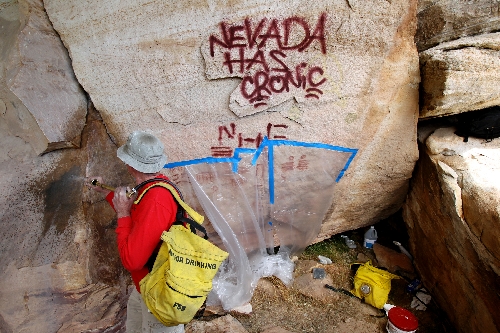Sentate Bill 257 imposes tougher punishment for graffiti taggers

Better think twice, spray-paint taggers. On Oct. 1, Senate Bill 257 became law.
It imposes the most stringent laws in the nation to punish those convicted of graffiti-related charges.
It came about, in part, from last year’s brazen attack on Native American art at Red Rock Canyon.
"I thought the Antiquities Act had pretty stringent penalties," said Mark Beauchamp, president of Friends of Red Rock, who added he was happy at the law’s stronger consequences. "Protecting our heritage is an important thing to do … it’s about time."
Senate Bill 257, from state Sen. Valerie Wiener, D-Las Vegas, makes offenses committed on any designated historic site in Nevada a category C felony, which comes with mandatory jail time. It allows civil lawsuits to be filed against the parents of children 18 or younger if the juveniles have defaced property with graffiti. The property owner now can seek triple damages, plus lawyer fees. The law also addresses counseling and community service.
Following on the tail of the new law’s effect, the Nevada Rock Art Foundation is launching a major fundraising and awareness initiative. The kickoff party, Adventures on the Rocks, is planned from 4 to 7 p.m. Saturday at Summerlin Life Time Athletic, 10721 W. Charleston Blvd.
Tickets are $25 at the door. Wine, catered hors d’oeuvres and live entertainment are planned. More than two dozen experience-driven trips and events will be up for auction. For more information, visit nvrockart.org or call 804-6723.
The foundation promotes the protection and public awareness of rock art in Nevada and surrounding areas, as well as identifying and documenting rock art thought to date back as far as 10,000 years.
The destruction of the Native American rock art at Red Rock Canyon was discovered in November 2010. A tourist who saw it alerted Red Rock Canyon officials. The graffiti included the street names "PWE," "RODO" and "64C," essentially leaving calling cards that helped police track down the perpetrator. News of the crime struck a nerve that surpassed Nevada’s borders.
"I’ve been receiving calls from Native American tribes and organizations across America, as well as citizens from every walk of life," said Kim Bush, liaison for Clark County Commissioner Larry Brown, in an email soon after the destruction became known. "The outrage sparked by this crime is far more than any other case I’ve ever been involved in."
U.S. District Judge Kent Dawson sentenced the teenage offender behind the egregious spray painting to nine months behind bars, time already served. The perpetrator also was placed on nine months of supervised release and ordered to pay $23,775 in restitution to the U.S. Bureau of Land Management.
Because he was 17, an underage offender, his identity was not released. He was, however, identified by his street moniker, "Pee Wee."
Even though the graffiti at Red Rock Canyon has been cleaned up, Beauchamp said the overt destruction of the rock art will be used as the "poster child" in future campaigns.
Immediately following the destruction, a zero-tolerance policy for spray-painted attacks went into effect. Friends of Red Rock trained dozens of volunteers in paint-removal techniques. Its graffiti task force can be alerted to new graffiti through a web-based alert system by visiting friendsofredrockcanyon.org and clicking on "share," accelerating the response time.
"This particular person didn’t realize how destructive he was," said Klaus Cobb, chairman for Friends’ natural resources committee. "We need to make people more aware."
On a related note, the Metropolitan Police Department has released the Community Resource and Information Guide on Gangs, Graffiti & Youth to the public. The booklet is a tool for parents, teachers and community leaders who deal with gangs and graffiti-related issues with young people.
For more information, visit lvmpd.com and click on "crime."
Contact Summerlin/Summerlin South View reporter Jan Hogan at jhogan@viewnews.com or 387-2949.